skip to main
|
skip to sidebar
###
This painting by Van Gogh is so uniquely beautiful that the Yasuda Insurance Company paid $39.9 million dollars for it.

But wait a minute... it turns out that Van Gogh painted three other paintings just like it.

Or maybe it was four? Nobody knows for sure.

Someone argued that the $39.9 million painting must be a forgery, and suddenly it didn't look quite so beautiful.
Art experts hastily assembled to explain which of the five paintings had the "look" of a genuine Van Gogh. Unfortunately, the paintings had changed colors over time. The chrome yellow oil paint had darkened from exposure to atmosphere and the green paint changed color because of the copper acetoarsenite in the pigment.
So whatever the buyers were acquiring, it was not the artist's original vision.
Scientists, scholars, technicians, reporters and historians evaluated the painting. Some prepared long lists of issues:
The first of these concerns the leaf that belongs with the drooping flower to the left, number 14, through which the flower-stem passes. Leaves encompassing the stem in this way are not characteristic of sunflowers. In the first version-- the work in London-- the stem runs slightly into the leaf, which may have created the impression of a leaf encompassing a stem. The second concerns the broken stem of flower number 4. When sunflowers snap, the top part falls forward...but surprisingly this is not the case here.
Others claimed that the value of the art could be determined by a chemical analysis of the paint:
The composition of the priming layer allows us to date the work.... If this layer does indeed prove to consist of both barium sulfate and lead and/or zinc white, it would be reasonable to assume that the still life was painted in late November, when [Van Gogh] replaced the first type of primer with the second.
These are fitting topics for insurance companies and investment managers but not for people who care about art. For artists, it is the image that matters.
This all takes us back to digital art, which has an image but no physical existence. In recent exchanges, some of you have correctly pointed out that electromagnetic pictures create problems regarding scarcity, originality, authenticity, and even the fundamental nature of talent. But as the Van Gogh story demonstrates, so do physical objects. Sometimes the object becomes an albatross around the neck of art. Computer art may be dismaying to those who want to build a fence around an object and sell tickets, but for those who want to create digital images and cast them into the ether, computers give artists astonishing new tools.
There are days when I am utterly charmed by the idea of art without the constraints of earthbound objects. Those days are usually Saturday and Sunday, when I'm not trying to earn a living. But there are also days when the physical object is quite dear to me. We are fortunate to be living in a time of great transition. (I have a friend who claims that the invention of computers linked by the internet is slightly less important for human destiny than the invention of fire, but slightly more important than the invention of agriculture). These things will take time to work out.
For me, the one sure guide as we go forward is the quality of the image. I enjoy the work of dozens of computer artists, and in the past couple of weeks, you have alerted me to many more. I hope that readers have, with me, been exploring the links that have been suggested.
I agree with many of you that Craig Mullins is an extremely strong digital (as well as conventional) artist. The man knows how to draw and paint, and he enlists the computer to serve that talent as well as anyone I've ever seen.
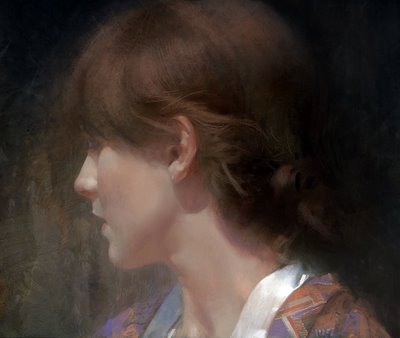
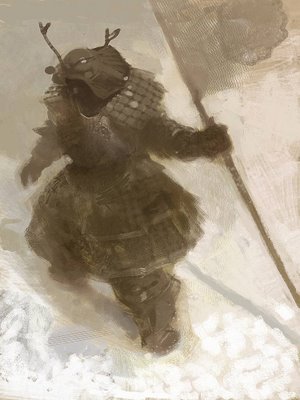
Mullins has a good sense of color and drama and a real flair for design and I shall be visiting his website regularly.
One of my favorite young digital artists is Daisuke “dice” Tsutsumi , a visual development artist for animated films such as Robots. Like Mullins, Tsutsumi also works in traditional media:
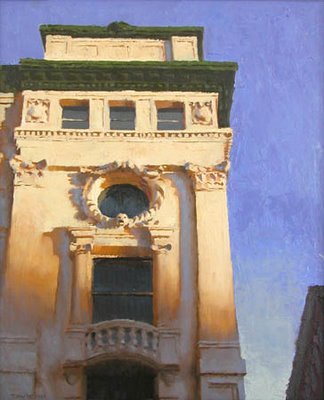
Here he offers an excellent digital painting workshop showing how to use photoshop to paint an apple that looks as juicy as a Dean Cornwell oil painting. He is still growing, but I especially like Tsutsumi's attitude toward art. He chirps happily about drawing and painting while traveling, while standing in the rain, while eating lunch at his job or visting his family. He reminds me of a line from Jake Berthot:
An artist is rich if he has time. 'Making it' means having the time to make your work.
Tsutsumi does "quick fun photoshop sketches" as seamlessly as he draws on a restaurant placemat. He is of the generation that will really begin to integrate and humanize computer art.
###
###
The great illustrator Dean Cornwell applied oil paint like he was buttering a croissant.
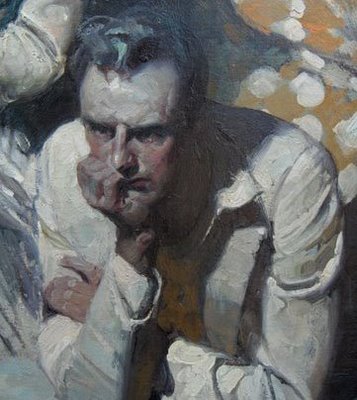
I see this painting every day, and the pleasure I take from it is both visual and tactile. Cornwell's artistry is revealed at the exact place where his imagination interacts with the physical universe-- the stretched canvas that first yields and then springs to the touch, the sable brushes that spread, flex and taper as they sculpt the colors. I know this artist better for the sensuous experience of running my fingertips lightly across this painting.
As another example, Ronald Searle dips his pen in his DNA. He scuffs, scratches and scribbles on paper with ink, water and color to create an object which reveals his identity more than any fingerprint ever could.
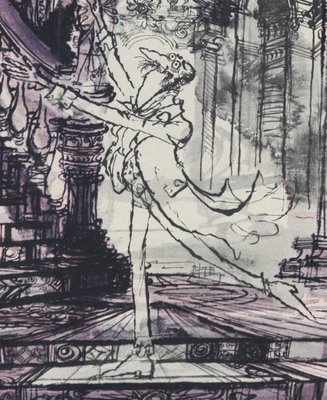
I am sure that Searle could have increased the efficiency of his output by using the photoshop deflavorizing machine to erase mistakes (and to miss out on happy accidents). I'm not sure the result would be quite as personal.
My third example, a painting which I wrote about recently, has a different kind of physical significance. It is smooth and polished, with a surface that is visually not much different from a digital image.
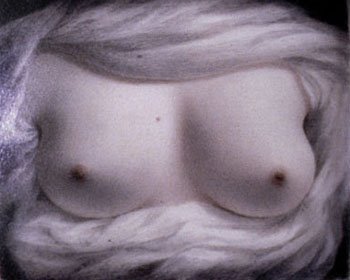
Its significance stems instead from the way the artist invested a small piece of ivory with enormous emotional importance. With each of a thousand tiny brush strokes, she probably wondered whether she was doing the right thing. With a thousand and one alternate brush strokes, she was probably exhilarated by the prospect of baring herself to her secret friend. It matters that there was a luminous object rather than a jpeg for her friend to clutch and hold close.
These examples show that a physical object can reveal additional qualities and add a different layer of meaning to art. Art that exists only as database of electromagnetic pulses can be just as beautiful as physical art, but I think we reserve a special sympathy for art that shares the mortality of physical things. Computer art is not made of perishable substance, and for that reason will always be a little more distant from the core of human concerns. As Thomas Mann wrote: Love is our sympathy with organic life, the touchingly lustful embrace of what is destined to decay.
In this regard, computer art (which never erodes or crumbles and can be perfectly replicated endlessly) leaves us behind. None of this means that computer art isn't superior for some purposes. I have been gratified by the comments from those of you who are also trying to make sense of this area. I concur with those of you, such as Szy or L.A. Stern, who appreciate the importance of an art object just as I agree with those of you like Stefan, John and Insomniac who see a great future for computer art. In the end, I am with those who say that the greatest potential for computer art is where it is not trying to mimic traditional media. I plan to spend a little more time exploring this neighborhood but before leaving "the importance of an object," I thought I'd offer you one last quote from my guy Walt Whitman.
His poem, Whoever You Are Holding Me Now in Hand speaks of the importance to his poems of a physical touch:
[I]n libraries I lie as one dumb, a gawk, or unborn, or dead,
But just possibly with you on a high hill— first watching lest any person, for miles around, approach unawares,
Or possibly with you sailing at sea, or on the beach of the sea, or some quiet island,
Here to put your lips upon mine I permit you....
Or, if you will, thrusting me beneath your clothing,
Where I may feel the throbs of your heart....
For thus, merely touching you, is enough— is best.
###
###
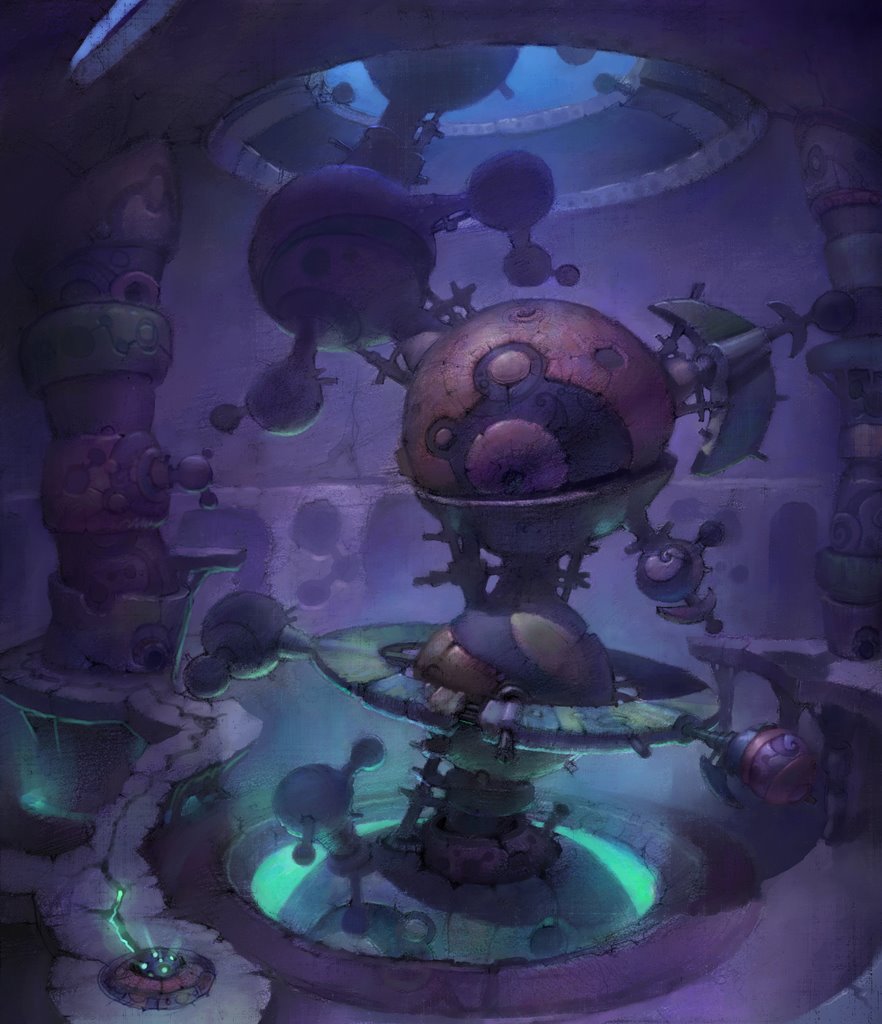 A nifty computer image from the blog of Disney concept artist Todd Harris In my last post, I mentioned that art originated in the paleolithic era after our ancestors discovered a type of rock that could be shaped into the first blades, flints and other tools that transformed human life. That special rock (cryptocrystalline siliceous) contained silica-- the same material that, 35,000 years later, we use to make semiconductors for computers. This fateful substance has now intervened twice in our history to alter human destiny.
A nifty computer image from the blog of Disney concept artist Todd Harris In my last post, I mentioned that art originated in the paleolithic era after our ancestors discovered a type of rock that could be shaped into the first blades, flints and other tools that transformed human life. That special rock (cryptocrystalline siliceous) contained silica-- the same material that, 35,000 years later, we use to make semiconductors for computers. This fateful substance has now intervened twice in our history to alter human destiny.
For that reason alone, it seems to me that computer art-- produced with silicon chips-- has earned a little patience and an open mind.
Computer art has now been with us for over 50 years (if you include the pre-ASCII images created with early Baudot code) For most of that time, computer art has been simply awful.
 Jennifer Bartlett wowed the art establishment by using computers to convey platitudes on LEDs
Jennifer Bartlett wowed the art establishment by using computers to convey platitudes on LEDs
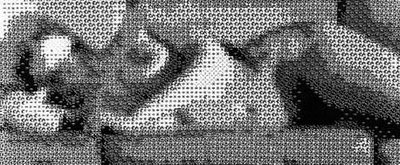 A computer modified image of a nude
A computer modified image of a nude
 Computer generated Op Art
Computer generated Op Art
The fundamental problem with the computer as an artistic tool is that computers are exclusively a technology for binary information, but binary information is not often a major ingredient of great art. Most art doesn't need more information-- it needs more wisdom, judgment and taste. One of my favorite thinkers on this subject is the ever insightful Karrie Jacobs, who wote: Computers have seduced us into thinking about ideas-- the intangible stuff that comprises our culture, our mental universe, our homegrown organic realities-- as information....With information technology, our reach is infinite but our grasp is weak.
Jacobs asserts that information should be our raw material, not our end product, and I agree with her. To the extent that computer art is finally getting interesting, it is where computers serve as a means to an end, and not the end itself. As with any new art tool, it takes time for artists to humanize and gain proficiency with computers (and to modify them to carry out the subtler instructions of the artist). But after fifty years, computers have become integrated into the conception, production and distribution phases of art. Some of this art is quite good. Some-- in my view-- is pretty bad.
Over the next few posts, I hope to engage in a dialogue with readers who know more than I do about computer art. Most of all, I am interested in how computers are changing the nature of the artistic process. Let's explore.
###
###
 At the earliest red dawn of humanity, our ancestors slowly learned to use stone tools. For more than 2 million years they used stones in the same way: to bash or chop. It was a brutish existence that left no traces of art or culture behind.
At the earliest red dawn of humanity, our ancestors slowly learned to use stone tools. For more than 2 million years they used stones in the same way: to bash or chop. It was a brutish existence that left no traces of art or culture behind.
Then, during the upper paleolithic period (35,000 to 12,000 years ago) stone technology took a great leap forward. Our ancestors learned how to select certain rocks that could be shaped into blades-- longer and lighter with more cutting surface. Using these stones, they developed tool making techniques that gave them ten times the cutting edge from the same sized stone.
This transformed their world. They could now use sharpened rocks for spear points and projectiles. They could cut with greater precision and for the first time make use of antler, ivory and bone. Hunting became easier. Conceptual thinking became more important to survival. The first signs of symbolic thought emerged. It was in this environment that the very first art began to appear, painted on cave walls and etched in bone. More artistic progress was made in those 25,000 years than in the preceding 2 million years combined.
Since those fragile beginnings, art continued to flourish in tandem with technology.
For example, Beethoven was able to revolutionize music partially because the invention of the piano gave him greater range and expressive capability than previous composers who grew up using the harpsichord.
And illustration art only became a phenomenon in the late 19th century when printing and photographic technology improved enough to reproduce artwork vividly and accurately for mass produced books and magazines. Without half tone engraving, there would have been no golden age of illustration.
It is useful to remember this long history in an era when technology sometimes seems dehumanizing and oppressive. Technology may push aside traditional art forms such as drawing and painting in favor of strange new art forms that screech and light up and move. But even the most sentimental among us (and I may qualify for that category myself) need to remain open minded as we assess the impact of technology on art.
The reason for my long, boring digression is that I want to chat in the next few installments about the nature of computers and digital art. I would love to engage in a dialogue with you dear readers about the future of art, and to be educated by you as I invariably am.
Are you ready?
###
###

Sarah Goodridge (1788-1853) was born in a small village in Massachussetts, the sixth of nine children. Growing up in the country, she learned to draw by scratching pictures with a pin on birch bark. Eventually she made her way to Boston where she earned a living painting miniature portraits on ivory.
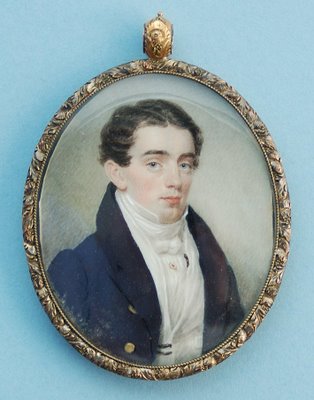
In the days before photography, such pictures were often worn in lockets or pinned to lapels.

Goodridge's miniatures were very popular and she soon flourished as an independent artist-- a rarity for a woman in colonial America. By painting two or three portraits a week, she made enough to support her sick mother, her orphan niece, and other family members. Her career lasted for thirty years until her failing eyesight forced her to stop. She never married.
Goodridge did, however, develop a special friendship with the handsome young Boston lawyer Daniel Webster. The first time she painted Webster's portrait, he was married with three children. He sat for eleven more portraits over the next 25 years. Webster and Goodridge wrote each other frequently; she carefully preserved letters from him, while he seems to have carefully destroyed letters from her. When he moved to Washington to serve in government she visited him there twice.
After Webster's wife died in 1827, Goodridge secretly painted this miniature for him entitled Beauty Revealed (self portrait):

Sarah's daring self-exposure was unthinkable in an era when modesty was carefully preserved by several layers of clothing. Her painting crossed all kinds of boundaries-- social, sexual, religious and artistic. John Updike describes this little jewel as "the first known nude American portrait done from life."

No one can ever be certain what Webster and Goodridge shared in private. Scholars have agreed that at a minimum, Goodridge's self-portrait told Webster, in the words of Updike, "we are yours for the taking." Could an object so small ever carry greater weight? Sarah's offering is not mere pigment on ivory. It shows how an artist invests a physical object with deep significance, and through that object reaches out to another human. It reminds me of Walt Whitman's impassioned effort to use a poem to reach beyond his mortality and touch some future reader who might be holding Leaves of Grass late at night:
Now lift me close to your face till I whisper,
What you are holding is in reality no book,
nor part of a book;
It is a man, flush'd and full-blooded -- it is I -- So long!
We must separate awhile --
Here! take from my lips this kiss;
Whoever you are, I give it especially to you;
Whatever their private relationship, Webster was politically ambitious and needed money, so Goodridge simply would not do for his second wife. He met and quickly married another woman, whose sole qualification seemed to be that she was from a wealthy and prominent family.
When Goodridge died, she left her beloved paint box to Webster.
As for Webster, he kept her tiny painting hidden amongst his personal effects until the day he died. It was discovered by his heirs and was eventually sold off.
This miraculous glimpse of a beating heart beneath the manners and undergarments of an earlier generation is now safely contained in an antiseptic museum showcase.
###


























